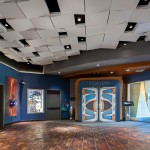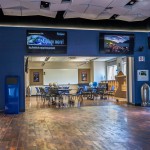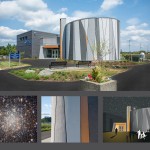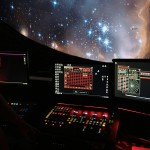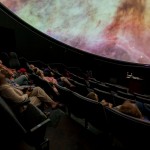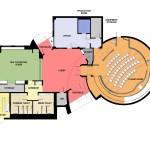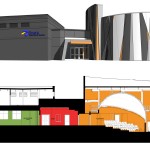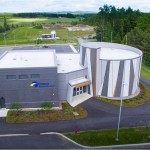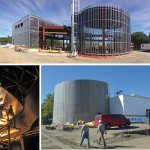Emera Astronomy Center
Project Name
Emera Astronomy Center at the University of Maine is helping sustain and enhance one of mankind’s longest pursuits – the study of the night sky. Designed by WBRC Architects Engineers, the 7,400 SF Emera Astronomy Center is fulfilling its mission to create an experience that is impressive to visitors of all ages.
In operation since late 2014, Emera Astronomy Center delivers its initial “wow” through the building’s asymmetrical exterior. Entrances to both the building and the theater are designed as portals to facilitate the illusion that one is passing from Earth to the outer reaches of space. In the lobby, the space theme continues with metallic floors, dramatic dark blue walls, and an undulating metal ceiling with star-like light fixtures.
The centerpiece of the center in the new Maynard F. Jordan planetarium, an ADA-accessible theatre that seats 50, designed in partnership with planetarium theatre expert Kasian of Vancouver, Canada. The planetarium’s 33-foot dome is tilted 22 degrees for more comfortable viewing, and a state-of-the-art Definiti projection system allows audience members to be fully immersed in the theater experience. The theater system can show Imax-type shows, 3D films, and project high-definition, scientifically accurate models of stars, planets, and galaxies from a host of vantage points, including the view from the adjacent observatory.
A few hundred feet away, a whole new level of observational astronomy is taking place on clear nights at the center’s 618 SF observatory, thanks to a 20-inch PlaneWave CDK 20 telescope and the building’s location on the darkest corner of campus. The observatory has significantly less light pollution than UMaine’s former facility, due in part to an innovative system red LEDs that illuminate the parking lot when the observatory is in use, preserving the dark sky critical to enhanced stargazing, while still making the facility safely accessible to student pedestrians.
Safely accommodating large groups of visitors, often school children, was also an important design consideration, so the chosen site has ample space for parking and visitor buses. Emera Astronomy Center includes a multi-purpose room used for classes, events, and hands-on activities. Other user- and staff-friendly features include multiple ticketing points-of-sale, a variety of digital displays, and the ability for groups to enter and leave from dedicated entrances.
Good stewardship of resources is very important at the University of Maine as well as to the project donors – including an anonymous giver who donated $3.2 million of the $5.2 million project costs, and energy company Emera of Maine, which made a $1 million naming gift. To create a sustainable facility, the design team chose a closed-loop geothermal HVAC system with electric thermal storage, which offered the best long-term energy efficiency. Targeted for LEED Silver certification, Emera Astronomy Center also incorporates LED lighting, a highly-efficient building envelope, and extensive use of local and recycled materials.
Architecture or A/E Firm Name
Architect
Team
Consultants
Location
Client
General Contractor
MEASURE 1: DESIGN & INNOVATION
- To fulfill the project vision of an impressive user experience, the design team created excitement through the use of innovative forms, materials, programming, and technologies, resulting in an astronomy center that adds to the “intellectual prosperity” of multiple generations, from pre-K students to parents to post-graduates.
- Space observation requires a dark sky; one motivation of the philanthropist who donated $3.2 to fund Emera Astronomy Center was to increase awareness of light pollution and the need to regain and sustain dark sky viewing of the stars and planets.
- The LEED-Silver targeted facility includes a closed-loop geothermal system with electric thermal storage, LED lighting, a highly-efficient building envelope, and extensive use of local and recycled materials.
- Upon entrance to the facility, an interactive kiosk educates visitors about Emera Astronomy Center’s sustainable features and the importance of maintaining a dark sky for space observation.
MEASURE 2: REGIONAL COMMUNITY DESIGN
- Site is located within a quarter of a mile of two public transportation bus stops with two or more routes.
- The state of Maine is the most forested state in the U.S. (85% timberlands), making it an outstanding place for observational astronomy and an optimal sight for a state-of-the-art planetarium and observatory.
- In addition to the longstanding scholarly pursuits of UMaine’s astronomy students, interest in the stars and planets has also recently increased among regional school children due in part to the work of the Challenger Learning Center in Bangor. Emera Astronomy Center, with its multi-generation programming, is designed to sustain and nurture these strengths.
- University of Maine’s former planetarium and observatory employed outdate technology, and were located in disparate parts of campus. Emera Astronomy Center was sited to provide a safer, more visible location for the new planetarium and to allow astronomers to observe space from the darkest corner of UMaine’s campus, both onsite and remotely from all over the world.
MEASURE 3: LAND USE & SITE ECOLOGY
- Emera Astronomy Center is located on a previously developed campus parking lot; no new ecosystems, watersheds or wildlife habitats were disturbed.
- The building and roadways design incorporates existing site contours, minimizing cutting and filling.
- Native plant species, including low bush blueberries, were specified to eliminate the need for irrigation and reducing maintenance.
- All stormwater runoff is captured and treated in a soil filter on the east side of the site before traveling to adjacent wetlands.
- The University of Maine’s adjacent 7-acre Littlefield Ornamental Trial Gardens was not impacted by the new facility.
MEASURE 4: BIOCLIMATIC DESIGN
- The main building is designed for high performance at a lower cost in Maine’s cold climate using geothermal technology.
- Unlike many university buildings, Emera Astronomy Center is open to the public throughout the summer, and its closed-loop geothermal system also provides cooling for year-round comfort.
- Site-specific design solution using a gravity-fed soil filter to mitigates stormwater runoff.
- Native plant selection reduces maintenance and requires no irrigation.
- Exterior lighting design accommodates dark sky observation.
- Geothermal heating/cooling circumvents fossil fuel price volatility, a major concern in Maine, while also eliminating fossil fuel carbon emissions.
MEASURE 5: LIGHT & AIR
- Multipurpose room and offices have ample daylighting and views of the back fields/observatory.
- Extensive interior use of LED lights to reduce energy demand and building heat loads.
- On evenings when the observatory is in use, red LED lights are used in the parking lot and pathways: Out of all the colors on the spectrum, red has the lowest disturbance of dark sky viewing.
- These red LED lights provide light levels that satisfy the university’s concerns about for pedestrian safety while creating minimal interference with observational astronomy.
- When the observatory is not in use, IESNA full cutoff lights illuminate the parking lot, providing additional lighting while reducing light pollution and light trespass.
- Inside and out, programmable lighting systems controlling the planetarium, lobby, multipurpose room, and exterior cycling offer specific scenes that change depending on the users’ needs and time of day.
- Dimmable red LED lighting on the floor of the planetarium theater allows occupants to exit during a performance without interfering with show visibility.
- Planetarium air handlers use 100% outside air for optimal air quality.
- Air in the planetarium is supplied from above the dome, flows through perforations in the dome to theatre occupants, and out through floor-level return grids, resulting in optimal fresh air flow with no dead spaces.
- HVAC design provides ventilation of air in excess of ASHRAE 62.1 requirements.
MEASURE 6: WATER CYCLE
- Project did not disturb neighboring wetlands due to placement on previously-developed parking lot.
- Water sourced from existing campus water mains.
- Nearby wetlands are protected from stormwater runoff via a soil filter located between the planetarium and observatory buildings.
- Emera Astronomy Center’s low flow fixtures reduce water use by 30%. Outside, no water is used to maintain landscaping.
MEASURE 7: ENERGY FLOWS & ENERGY FUTURE
- Energy efficiency and conservation of resources informed every major design choice, including closed-loop geothermal, LED lighting, recycled building materials, and site selection on a previously-developed parcel.
- The project team’s decision to use a geothermal system rather than oil or natural gas both reduces future costs and makes them more predictable, while also reducing the facility’s ongoing carbon footprint.
MEASURE 8: MATERIALS & CONSTRUCTION
- Low emitting materials were selected for the project; all wood products are urea -formaldehyde free, and all paints, adhesives, sealants and flooring contain low to no VOCs.
- Highly-efficient building envelope help mitigate wind chill and heat gain on the center’s hilltop location.
- Durable flooring and finishes were selected to minimize maintenance and increase longevity.
- Recycled building materials include steel, concrete, and gypsum.
MEASURE 9: LONG TERM FLEXIBILITY AND ADAPTABILITY
- Site and building plans were designed to include the possible future addition of the Challenger Learning Center or similar expansion to the classroom/support side of the building.
- Emera Astronomy Center’s multi-purpose room has an open design, optional sliding wall, and movable furnishings to allow quick and easy reconfiguration for use as either a separate meeting /classroom space or an extension of the lobby area.
- Planetarium lobby includes multiple ticketing and display options.
- Separate entrance and exit doors and dedicated bus drop off/pick up areas allow flexible movement of large groups of students.
- Flooring, finishes, and fabrics were all selected for durability as well to enhance user experience.
- Flexible, programmable lighting adapts to specific needs and events.
MEASURE 10: COLLECTIVE WISDOM & FEEDBACK LOOPS
- Dynamic interactive kiosk informs visitors of Emera Astronomy Center’s sustainable features and educates them on the importance of dark sky observation.
- Other interactive displays in the lobby provide instant feedback to enhance learning and information retention.
- A follow up team meeting in early 2016 will compare projected energy data with actual data from the first full year of usage.


